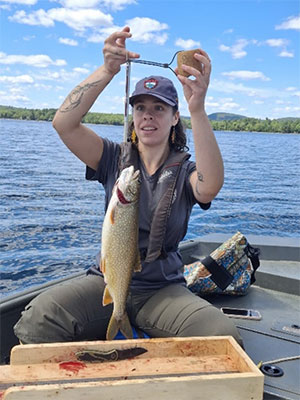Home → Fishing & Boating → Fishing → Fishing Report
Fishing Report
Click the links below for the most up-to-date fishing news and suggestions from Maine's fisheries biologists.
The December and January Fishing Report lists several small bodies of water that typically freeze first, but it is up to you, the angler, to test for ice safety. Remember to always use extreme caution when venturing onto Maine's waterways. Accessing lakes and ponds should be avoided unless you can be certain of ice conditions by checking ice thickness. Before stepping out, use a chisel or auger to test ice thickness in several places. Remember that ice seldom freezes uniformly and conditions are always changing and can vary from one location to the next. Ice that forms over flowing water and currents, especially near streams, bridges and culverts, can be particularly dangerous. We hope you have a great ice fishing season! Learn more about ice safety.
Before you head for a day of fishing, ALWAYS tell someone where you are going and when you will return. Please enjoy the Maine outdoors safely and responsibly!

 Sebago Lake Region
Sebago Lake Region
From Fisheries Resource Biologist Brian Lewis, Written 12-18-25
Ice fishing season is upon us with cold temperatures from the last two weeks building ice on small ponds and coves of larger waters, although the December 19 rain may impact conditions. While many lakes and ponds are closed to harvest until January first, plenty of ponds are stocked specifically for that early season fish fry. Hobbs Pond, Paris, Otter Ponds number two and four in Standish as well as Littlefield Pond in Sanford are all stocked with brook trout for the early ice fishing season. While harvest on most brown trout waters are reserved for after January first, brown trout can be legally kept in December at both Hobbs Pond and Halls Pond in Paris.
Rainbow trout harvest is entirely reserved for after December but early January ice fishing for rainbows can be hot. Anglers willing to jig small bait like worms and grubs in shallow weedy coves can have some spectacular catches. Targeting those shallow weedy coves is key as the rainbows are attracted to the aquatic insects associated with the plant life. Stanley Pond in Hiram, Upper Range Pond in Poland, and Norway lake in Norway are all good bets for early January action on rainbows.
Remember, early ice fishing is a great way to spend time in Maine's outdoors but it also comes with its fair share of hazards. Fish with a buddy and check ice thickness often.
 Belgrade Lakes Region
Belgrade Lakes Region
From Fisheries Resource Supervisor Jason Seiders, Written 12-15-25
Late December
Stocked Brook Trout Ponds: This winter appears to be shaping up well in terms of ice conditions, although the December 19 rain will impact conditions. Many of these smaller trout ponds freeze up early because they're relatively small and sheltered. Most of these waters are heavily stocked with a variety of trout sizes, providing awesome opportunities for anglers of all ages. In addition to stocked brook trout, many of these waters have robust populations of bass, pickerel, perch, and other fish to keep the flags popping and the jig rods busy. Here's a list of some great brook trout opportunities across the region:
- Levenseller Pond (Searsmont)
- Tolman Pond (Rockport)
- Knight Pond (Lincolnville)
- Ross Pond (Bristol)
- Kaler Pond (Waldoboro)
- Maces Pond (Rockport)
- McGrath Pond (Oakland)
- Hosmer Pond (Camden)
- Brettuns Pond (Livermore)
- Round Pond (Livermore)
- Pinkham Pond (Alna)
- Sewell Pond (Arrowsic)
- Charles Pond (Georgetown)
- Caesar Pond (Bowdoin)
Early January
Flying Pond (Vienna): Flying Pond is a gem in this region of the state. It has an incredible smelt population that supports the growth of salmon and brown trout. We measured some really nice fish during our fall survey, and those fish are still swimming! Lots of salmon around 20 inches, and brown trout up to six pounds. Flying Pond also receives a good number of brook trout, and the bass fishing can be incredible.
Parker Pond (Fayette, Vienna): The Parker Pond salmon fishery has improved a bit in recent years and it's definitely worth a shot when the ice gets safe. Our recent work on Parker showed good numbers of salmon between 16-20 inches, and we stock a decent number of brook trout for the ice fishing season. White perch numbers have increased in Parker Pond over the last several years, so it's a great place to target some panfish for fun or table fare.

MDIFW Microbiolgoist Marielle Thomas weighing an average
sized lake trout while sampling Swan Lake this summer.
Swan Lake (Swanville): This will be the second ice fishing season open to no size or bag limit on lake trout on Swan Lake. To all the anglers that harvested lake trout here last winter – thank you……..but we need more! Our surveys this summer revealed that we need more lake trout harvested if we're to see improved fish quality and the return of a stable salmon stocking program. Lake trout condition is definitely better than it was a few years ago, and we've been able to stock a small number of salmon now that we're seeing a return in the smelt population. These lake trout are definitely worth the trip with many fish in the 16-23 inch range, and much more robust than they were just a few years ago. Anglers may also find some occasional bigger fish; some pushing 30-inches long. With your help we hope to have more large-size fish in the near future – harvest helps alleviate competition for food and habitat when fish populations are too high.
Fishing tip: I can't emphasize this enough – if you're fishing for brook trout, stay shallow! You are far more likely to encounter brook trout when you fish in water depths of 5-feet or less. Additionally, keep your tackle and bait relatively small. Don't try fishing for brook trout with hooks meant for largemouth bass. A size 6 hook with a small piece of worm or nightcrawler will work great. If you really want some fun, try jigging with a small spoon or jig tipped with a tiny piece of worm. Often times you'll see the brook trout approach your lure and watch the fish hit.
 Grand Lake Region
Grand Lake Region
From Fisheries Resource Supervisor Jake Scoville, Written 12-18-25
Report for Late December/January
It has been several years since we have had this much early safe ice here in the Downeast region. A good, hard, cold snap doesn't get everyone in Downeast Maine excited, but the ice anglers sure do get fired up. We are off to a great start, but keep an eye on the weather as things can change quickly with a stretch of mild weather, especially on the coastal waters.
Where to fish:
Early ice is just that. Early ice. That doesn't mean every lake is ready to fish. Safety needs to be priority one. But, luckily, the Downeast Region has a number of waters that typically offer anglers good brook trout fishing that stay safe in the early season. Williams Pond in T28MD and Lovejoy Pond in T34MD are hot spots this time of year. Both waters are accessed off dirt roads, so with the lack of snow, they are easily fishable.
As January progresses and the ice hopefully follows suit, larger lakes will become safe. If you're seeking a diverse range of species, Mopang Lake and Pleasant River Lake, both off Route 9, are excellent choices. Mopang has been providing anglers with salmon, splake, and white perch. Pleasant River Lake has gained popularity in the past 10, years and for good reason. Anglers are catching splake, brook trout, salmon, and white perch. Both are great options in January.
The large, deep Downeast lakes have not been safe to access until mid to late January recently, so I would still advise caution for those venturing onto them. You might find some safe ice on parts of those lakes in January, and hopefully by the end of the month, they will be good to go. If you're aiming to catch some lake trout in January, I recommend trying Pocumcus Lake in T6ND. Recent surveys indicate anglers should have high catch rates of togue between 18-23 inches. Salmon and whitefish are also commonly caught by anglers at Pocumcus.
Tips:
Don't hesitate to jig for brookies! I strongly suggest jigging, and while trap fishing is always enjoyable, I usually catch more fish with the jig rod. So, don't be afraid to move around and locate the fish. Sometimes staying in one place can decrease your catch rates.
Reminders:
Six Mile Lake in Marshfield and Long Pond in T10SD were designated under general fishing laws in 2025. Anglers who fished these waters reported great success catching brook trout at Six Mile Lake, and both brookies and brown trout at Long Pond. Don't forget about these new ice fishing opportunities early in the season. As always, be sure to check the most current fishing laws before heading out this year.
 Rangeley Lakes Region
Rangeley Lakes Region
From Fisheries Resource Supervisor Dylan Whitaker, Written 12-18-25
Winter has really announced itself this year with some bone chilling cold. We have already had a few mornings with sub zero temperatures in the Rangeley Lakes Region, and it's looking like we should have a good start for the ice fishing season. Many of our small ponds already have enough ice to fish on, and early season anglers have been enjoying some excellent fishing.
There are a few early opportunities in the Rangeley Lakes Region that can usually be counted on for some good early season action and good ice. Crowell Pond in Chesterville is a brook trout stocked water with great access off rt 41 in New Sharon. Crowell Pond also has good sized white and yellow perch, and largemouth bass making it a great place for kids. Another early season water with great access that usually has good ice is Beaver Pond in Township D. Rt 17 runs along almost the whole north shore, providing excellent access. This shallow pond is stocked with brook trout and is good fast fishing. As always, when fishing early season, be safe. Check the ice conditions thoroughly and consider wearing a PFD or investing in one of the many different brands of floating outerwear specifically designed to keep you safe while ice fishing.
Once January 1st passes and the regular ice fishing season begins, anglers looking to get off the beaten path and have a pond to themselves might consider Austin Pond in Bald Mountain Twp. This 684 acre, 34 foot deep pond will require a long walk or a snowmobile ride along the Austin Pond Road from the Deadwater Road off Rt 16. Anglers willing to make the trek will find a healthy stocked brook trout fishery, and a wild salmon fishery that produces moderately sized but fat fish. Austin Pond was opened to ice fishing in 2022, so the ice fishing season is still quite new. If you do make the trek, take a moment to tell your local biologist about your fishing trip. The data you provide is important to creating and managing the fishery for happy anglers.
Wentworth Pond, or Ironbound Pond depending on where you're from, in Solon is also a good bet for opening day ice. Access is easy via the Hole in the Wall Road and then the West Shore Road. There is an MDIFW launch at the end of the road that can provide a good place to park and access the water. This 213 acre, 48 foot deep pond is stocked with 500 brook trout in the spring and 800 in the fall, as well as 300 splake in the fall, and 150 brown trout in the fall. This gives anglers the opportunity to catch an assortment of excellent coldwater sportfish. This year it also received 30 adult retired broodstock brown trout as well. At over 18" long, one of these brown trout would create a lasting memory. It is also well known for large white perch and smallmouth bass.
Fishing Tips:
Ice fishing close to shore is a safe bet when fishing early ice, as brook trout typically like to cruise the shallows to feed. Jigging in shallow water can be a lot of fun too, when the ice conditions are right, you can watch a brook trout take your jig or bait right under the ice.
Reminder: Always check the regulations when fishing a new water. Many of the waters open to ice fishing in the Rangeley Lakes Region only allow dead bait or artificial lures. Those that allow live bait will have the S-11 regulation. If it doesn't have that in the North Zone, it's dead bait only. Check out the Fishing Laws Online Angling Tool for an easy way to check the regulations and have a good day on the ice.
 Moosehead Region
Moosehead Region
From Fisheries Resource Supervisor Tim Obrey, 12-15-25
The cold weather in November and December has set us up nicely for some early ice fishing this winter. As always, anglers should use caution especially when fishing in an unfamiliar location. There should be some good late December fishing on ponds like Branns Mill Pd, Harlow Pd, Manhanock Pd, Snows Pd, and Fitzgerald (Mountain View) Pd. These waters are shallow, so they freeze early and they were all stocked with some very handsome brook trout late in the fall.
Big Wood Pond and Little Big Wood Pond in Jackman are also great options in early January. Anglers can expect to find some nice splake with an occasional brook trout or salmon to spice up the catch. The snowmobiling and hospitality are always top notch in the Jackman area too.
Anglers might also try some of the smaller ponds further north near the Golden Rd to find good ice conditions in early January. Deer Pond, Holbrook Pond, and Chesuncook Pond are good bets for some quality splake.
Fishing tips: Brook trout really prefer the shallow water, so try worms or small baitfish in water less than 10 feet deep. Anglers targeting splake should focus on fishing just off the bottom in 10 to 30 ft with baitfish. Salmon are more likely to be suspended over deep water, so try fishing right under the ice. Don't forget to check your monofilament leaders when fishing for the first time. Good luck!
 Penobscot Region
Penobscot Region
Fisheries Resource Biologist Zachary Glidden, Written 12-15-25
Anglers looking for a chance to put an early season brook trout on the dining room table would be wise to visit a few of our popular stocked fall yearling waters. Wiley Pond in Patten is an early favorite for area residents and offers anglers a good chance at catching large brook trout, it can be accessed off the American Thread Road. Located off North Road in Brownville, Norton Pond is another hot spot for area anglers looking for brook trout. Lastly, Mud Pond (Perch Pond) in Old Town is another early season family favorite and easily accessed at Sewell Park.
Anglers looking for a more remote setting might try their hand at Spring Lake, T3 ND where landlocked salmon, brook trout, and white perch can be found. Further north anglers looking for a brook trout challenge should stop into Lunksoos Lake, T4 R7 WELS. Both lakes are best accessed on snowmobiles and anglers should be aware of active logging operations in the area.
As we head into the 2026 ice fishing season there is a regulation change that will take effect at Schoodic Lake in Lake View Plt. Schoodic Lake, long known for its impressive landlocked salmon, robust togue (lake trout), and hook & line smelt fisheries, is feeling the pressure of an overabundant togue population. Beginning January 1st, anglers are strongly encouraged to take advantage of the new size and bag limits on togue. With a little help from anglers, Schoodic will once again produce some of the best landlocked salmon in the state and togue fishermen will be seeing the healthy togue they remember from years past. The MDIFW launch in Lake View Plt is a popular access point as well as Knights Landing in Brownville.
SCHOODIC LAKE, Brownville, Lake View Plt, T4 R9 NWP (North Zone). General fishing laws apply, except: B (Open to ice fishing and open water fishing from January 1 - April 30). S-2 (Closed to the taking of smelts, except by hook and line), S-3 (Direct tributaries closed to the taking of smelts), S-11 (The use or possession of live baitfish/live smelts is permitted), S-19 (Daily limit on brook trout [includes splake and Arctic charr]: 2 fish), S-22 (Daily bag limit on landlocked salmon: 1 fish). Minimum length limit on landlocked salmon: 21 inches. No minimum size or bag limit on togue less than 23 inches. Daily bag limit on togue greater than 23 inches: 1 fish. From October 1 - December 31: ALO (Artificial lures only), S-7 (All trout, landlocked salmon, and togue caught must be released alive at once); Except that togue may be harvested as described above.
Ice anglers at Cold Stream Pond in Enfield are expected to have a great season. Recent fisheries work showed the landlocked salmon to be doing extremely well and we estimated the spawning togue population to be around 5,661 fish. A large number of legal sized, 18" – 19", togue are available to anglers and should make for a fun day of jigging. Anglers can also expect cusk and brook trout to be part of the catch here.
Fishing Tip: Anglers should target shallow structures and weed beds for actively feeding brook trout. The technique of using a small shiner and worm on the same hook, known as the "Happy Meal" by this biologist's family, is a proven method to harvest early season brook trout.
Reminder: Always check the ice conditions when fishing. Late December and early January ice can vary dramatically from pond to pond. Take extra care around inlets and outlets as they are often the last to freeze.
 Fish River Lakes Region
Fish River Lakes Region
From Fisheries Resource Supervisor Frank Frost, Written 12-18-25
Northern Maine is under a more normal weather pattern as of mid-December. We have ice forming on lakes and ponds now making for some early season opportunity and the prospects for all the January 1st openers looks very promising. It has been several years since we've had such good ice conditions by this time of the season. As a bonus, we currently have enough snow for travel by snowmobile.
Places to fish early: northern Maine now has a lot of opportunities for ice fishing as soon as the ice forms and is safe for travel.
- Scopan Lake, Masardis, Ashland – a water close to population centers with good access, this water is stocked with salmon and splake and also has a robust smelt population
- Trafton Lake, Limestone – a new water opened to ice fishing recently, this water is stocked with brook trout annually and still has trout that reach 14-16 inches
- Arnold Brook Lake, Presque Isle – a very popular water that forms ice early and is stocked with brook trout annually, access is easy and a short day trip is possible in very close proximity to Aroostook's largest population center
- Spaulding Lake, Oakfield – for southern Aroostook anglers, this water is easily accessible and is stocked annually with brook trout
Most of northern Maine's ice fishing opportunities begin on January 1st. Whether you want to do a short trip close to home or venture into the North Maine Woods, northern Maine is loaded with options for winter anglers.
- Fish River Chain – the best known group of waters in northern Maine, this large waterway has options for each of our popular sport fish, which are listed below in order starting with the best option, and has easy access at many locations for anglers who are seeking a short trip close to home. Many of these waters have abundant salmon, trout and togue with limits that allow significant numbers of fish to be harvested daily; anglers are encouraged to harvest their catch whenever possible. Landlocked Salmon – Long Lake, Cross Lake, St. Froid Lake; Brook Trout – Square Lake, Eagle Lake; Lake Trout (Togue) – Eagle Lake; Rainbow Smelt – St. Froid Lake, Long Lake, Eagle Lake; Burbot (Cusk) – Eagle Lake, Square Lake.
- Allagash Wilderness Waterway and surrounding area - this well-known group of waters are remote with abundant opportunities for native species. These waters require a lot of travel by truck and snowmobile and multi-day trips are usually necessary to fully explore each water. All of these waters have strong populations of Lake Trout and Brook Trout. First, Second, and Third Musquacook Lakes and Big Eagle, Churchill, Clear and Spider Lakes are some of the waters in the western area of Aroostook and northern portions of Piscataquis Counties.
Early season fishing tips: Rainbow smelt are the preferred baitfish species in northern Maine so anglers are encouraged to seek out their closest source of smelt whether it be a baitshop or a water that allows angling for them. Brook trout are often targeted on rocky shoals that are 3 – 6 feet water depth; small smelt work well for trout but if availability is an issue, small dace also work well with the key factor the size of bait – trout prefer the smaller baitfish.
A nice benefit to the sport of angling is the possibility of providing fish meals at home after a long day on the ice. Northern Maine has many opportunities for harvesting fish so anglers are encouraged to take advantage of these opportunities. There are many possibilities for preparing sport fish for consumption whether it be smoking, baking, or grilling. Anglers can do some research before their trip to plan ahead for fish care and preparation. Doing so can provide some healthy meals at home.